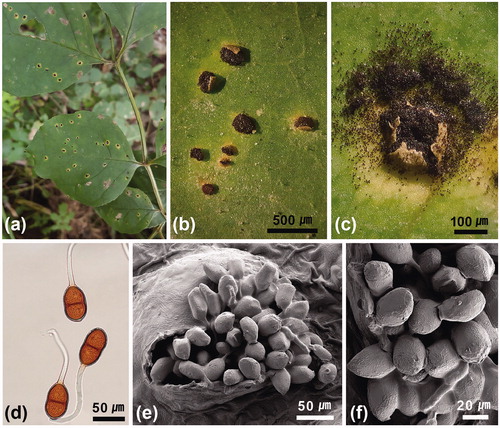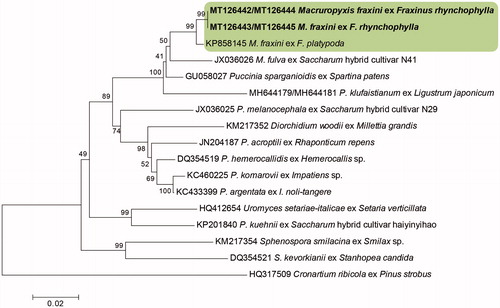Abstract
Macruropyxis fraxini has been recorded on several species of Fraxinus in China, Japan, Russia (Far East), and North Korea since its first recorded observation as a rust fungus on F. rhynchophylla in Jilin, China, in 1899. In the Korean Peninsula, the rust fungus was first recorded on F. rhynchophylla in 1935, based on four specimens collected at Mt. Kumgangsan, Gangwondo Province, in the North Korean territory. We confirmed this rust in the Korean Peninsula after 82 years. The rust fungus was identified based on morphological characteristics and a molecular phylogenetic analysis. This is the first record of M. fraxini in South Korea.
Fraxinus rhynchophylla Hance, commonly known as the East Asian ash, grows in moist, fertile soils on hillsides and in river valleys in China, Korea, and Japan (https://species.nibr.go.kr). In Korea, F. rhynchophylla is a species that naturally regenerates and dominates after thinning, thereby promoting the restoration of native hardwood forests. The species is also an important wildlife habitat, stabilizes stream banks, and provides organic matters to the forest. Its wood is commonly used for the manufacture of furniture, sports equipment, and tool handles, owing to its hard, dense, but elastic properties. In addition, its bark contains useful chemical compounds, and has thus long been utilized for medicinal purposes in Asia [Citation1].
Three species of rust fungi have been recorded on Fraxinus spp. globally (http://nt.ars-grin.gov/fungaldatabases). Puccinia fraxinata (Link) Arthur has been recorded on more than five species of Fraxinus, exclusively in the United States, since it was first recorded in 1825 as Caeoma fraxinatum Link. Aecidium fraxini-bungeanae Dietel was recorded on F. bungeana var. pubinervis (Blume) Wenz. in Japan in 1903, but no further studies have been conducted on its identity [Citation2,Citation3]. Macruropyxis fraxini (Kom.) Azbukina has been recorded on six species of Fraxinus, all of which are native to East Asia, including the Far East of Russia, China, Korea, and Japan [Citation4].
In Korea, Hiratsuka first recorded M. fraxini on the basis of four rust materials on F. rhynchophylla collected in 1934 at Mt. Kumgangsan (currently within the North Korean territory, approximately 38°39′N 128°11′E) [Citation5]. Since that time, there have been no additional records of this rust fungus on F. rhynchophylla in the Korean Peninsula [Citation6]. During our extensive forays for phytopathogenic fungi, for the first time in South Korea, we found a rust fungus on the leaves of F. rhynchophylla at Hongcheon in 2016, and again at Hongcheon and Chuncheon in 2017 and 2018.
Voucher specimens of the leaves of F. rhynchophylla have been deposited in the Korea University Herbarium: KUS-F29396 (September 1 2016, Hongcheon), KUS-F29991 (September 2 2017, Chuncheon), KUS-F30071 (September 26 2017, Hongcheon), and KUS-F30810 (September 10 2018, Chuncheon).
To perform morphological observations, the fungal structures were detached from the pustules using watchmaker’s forceps and water-mounted on glass slides. The morphology of the telia, teliospores, and pedicels was examined using a bright field and differential interference contrast (DIC) light microscope (Olympus BX51; Olympus, Tokyo, Japan) and a Zeiss AX10 microscope equipped with an AxioCam MRc5 camera (Carl Zeiss, Oberkochen, Germany). The microstructure of telia and teliospore was observed using a field-emission scanning electron microscope (SUPRA 55VP; Carl Zeiss).
Rust pustules on leaf surfaces were circular, subcircular to irregular, brown to dark-brown, crust-like, and granular (). Telia were predominantly formed on the adaxial surface of leaves but rarely also found on the abaxial leaf surface and young stems, exposed, chestnut-brown to dark-brown, and 100–300 μm in diameter, occasionally reaching 1000 μm (n = 30) (). Teliospores were ellipsoid, 36–57 × 25–38 μm, 2-celled, inner wall brown, 4–6 μm thick, outer wall hyaline, smooth, germ pores 2–4 per cell; pedicels were hyaline, composed of cell walls with loss of cytoplasm, 4.5–6.5 μm wide, and up to 120–280 μm long (n = 30) (). These morphological features were consistent with the description of M. fraxini on Fraxinus spp. reported by Azbukina in 1972 [Citation4], except for a slight difference in the size of teliospores, viz., 35–55 × 23–35 μm. Spermogonial, aecial, and uredinial stages were not observed in both studies.
Figure 1. Macruropyxis fraxini on Fraxinus rhynchophylla. (a) Symptoms on the adaxial leaf surface. (b) Telia developing on the abaxial leaf surface, surrounded by a yellow halo. (c) Magnified view of an erumpent telium. (d) Median view of teliospores under a light microscope. (e and f) A telium showing a group of teliospores (e) and close-up of teliospores (f) observed under a scanning electron microscope.

Genomic DNA was extracted from the rust pustules harvested from infected leaves and amplified with the rust-specific primer sets Rust2inv/ITS4rust, Rust2inv/LR6, and LRust1R/LR6 [Citation7]. An approximate 1400-bp region of the 5.8S subunit, the internal transcribed spacer 2 (ITS2), and large-subunit (28S) were sequenced. The assembled sequences were compared with entries in the NCBI database using the BLASTn program. For phylogenetic analysis, the combined sequences of the 5.8S, ITS-2, and 28S regions of the rDNA were initially aligned with rust species retrieved from GenBank and manually edited. Cronartium ribicola was used as an outgroup taxon (GenBank Accession No. HQ31709). A phylogenetic tree was constructed using MEGA7 [Citation8] based on neighbor-joining (NJ) analysis. Gaps in the sequence alignment were treated as deletions. The strength of the internal branches of the resulting tree was determined with a bootstrap analysis of 1000 replications.
The ITS and LSU sequences obtained from our two specimens (KUS-F29991 and KUS-F30071) have been deposited in GenBank (ITS: MT126442 and MT126443, LSU: MT126444 and MT126445). In a BLASTn analysis, they showed high similarities (ITS: 99.08% and LSU: 99.31%) with M. fraxini. Our phylogenetic analysis indicated that the combined sequences of the ITS and LSU regions clustered in the same clade with the reference sequence of M. fraxini parasitic to F. platypoda ().
Figure 2. Phylogenetic relationship between Macruropyxis fraxini and related rust fungi retrieved from GenBank, inferred by the neighbor-joining (NJ) method using the 5.8S, ITS2, and partial LSU rDNA sequences. Bootstrap values based on 1000 replications are indicated at the branches. The scale bar represents 0.02 nucleotide substitutions per site. The Korean isolates described in this study are shown in bold.

The genus Macruropyxis was established by Azbukina to accommodate Uropyxis fraxini, which was originally designated as Puccinia fraxini by Komarov in 1899. M. fraxini (Kom.) Azbukina had been the only species in this genus until the inclusion in 2017 of M. fulva, a rust fungus infecting sugarcane in southern Africa [Citation9]. Nevertheless, the identity of the genus Macruropyxis remains contentious, as to whether it should be accorded a distinct genus status or be included in the genus Puccinia [Citation7]. Therefore, more information on diverse isolates of M. fraxini would contribute to solving this ambiguity.
M. fraxini has been collected from five species of Fraxinus, including F. rhynchophylla (http://www.indexfungorum.org) exclusively in East Asia. Hiratsuka first recorded Uropyxis fraxini in the Korean Peninsula on the basis of rust-infected F. rhynchophylla collected at Mt. Kumgangsan. Since that time, there have been no additional collections or records of ash rust in North Korea [Citation6]. The description reported herein is an official record of M. fraxini confirmed in the Korean Peninsula after 82 years and is the first record of this species in South Korea. Information on the ITS and LSU sequences, as well as the morphological characteristics of the South Korean isolates, will contribute to our understanding of the generic concept of Macruropyxis and the species identity of M. fraxini.
Disclosure statement
No potential conflict of interest was reported by the author(s).
Additional information
Funding
References
- Wu ZD, Liu Y, Tian SS, et al. Chemical constituents of the stem bark of Fraxinus rhynchophylla. Chem Nat Compd. 2014;49(6):1162–1163.
- Tai FL. Sylloge fungorum sinicorum. Academia sinica. Beijing, China: Science Press; 1979.
- Hiratsuka N, Sato S, Katsuya K, et al. The rust flora of Japan. Ibaraki: Japan; Tsukuba Shuppankai, Takezono; 1992.
- Azbukina ZM. Physiologic specialization of Puccinia graminis Pers. in the Soviet Far East conditions. Proceedings 3rd European and Mediterranean cereal rusts conference, Prague. Vol. 2. Wageningen: European and Mediterranean Cereal Rusts Foundation; 1972. p. 87–89.
- Hiratsuka N. Uredinales collected in Korea I. Bot Mag Tokyo. 1935;49(579):145–152.
- Pastirčáková K, Shin HD. Contribution to the pathogenic fungi on woody plants in North Korea. Phytotaxa. 2017;299(2):185–198.
- Aime MC. Toward resolving family-level relationships in rust fungi (Uredinales). Mycoscience. 2006;47:112–122.
- Kumar S, Stecher G, Tamura K. MEGA7: molecular evolutionary genetics analysis version 7.0 for bigger datasets. Mol Biol Evol. 2016;33(7):1870–1874.
- Martin LA, Lloyd Evans D, Castlebury LA, et al. Macruropyxis fulva sp. nov., a new rust (Pucciniales) infecting sugarcane in southern Africa. Australasian Plant Pathol. 2017;46(1):63–74.
